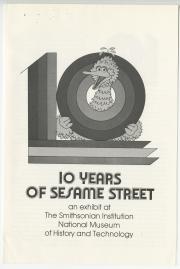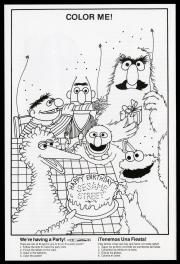 “What if you could create content for television that was both entertaining and instructive?” It was a question posed at a dinner party in 1965, after Carnegie Foundation vice president Lloyd Morrisett had observed his pre-school aged daughter sitting intently in front of the television one morning. What if educational content went down “more like ice cream than spinach?” What could the impact be for kids?
“What if you could create content for television that was both entertaining and instructive?” It was a question posed at a dinner party in 1965, after Carnegie Foundation vice president Lloyd Morrisett had observed his pre-school aged daughter sitting intently in front of the television one morning. What if educational content went down “more like ice cream than spinach?” What could the impact be for kids?
Four years later, the first episode of Sesame Street premiered on PBS--the first of the more than 4,300 that have aired to generations of pre-schoolers across the globe since. The show spurred new studies into how children’s programming could help meet broader education goals, and the impact the show could make on helping prepare children--particularly those from low-income areas--for school. As Malcolm Gladwell later wrote: “Sesame Street was built around a single, breakthrough idea: that if you could hold the attention of children, you can educate them.”
That revolutionary concept was at the heart of the “Ten Years of Sesame Street” exhibit at the Smithsonian’s Museum of History and Technology, now the National Museum of American History, in the summer of 1979.
As Curator of the Division of Community Life Carl H. Scheele wrote of the exhibit proposal in 1978, “Sesame Street has had a telling impact on both the nature of children’s television programs and techniques in primary education.” As the exhibition’s brochure would later describe, Scheel’s division was “concerned with the history of education and entertainment,” and Sesame Street had “a significant impact” in both sectors in just its first decade on air.
 That significance was supported by the numbers, sent to the Smithsonian from the Children’s Television Workshop (CTW) during exhibit planning. Just shy of a decade on-air, the show reached over 80 percent of homes in the U.S. with children ages six and under (and another 9 million households with older children or no kids at all). The show had begun reaching millions of kids outside of the U.S, too, with translations and adaptations in multiple languages throughout Europe and Latin America.
That significance was supported by the numbers, sent to the Smithsonian from the Children’s Television Workshop (CTW) during exhibit planning. Just shy of a decade on-air, the show reached over 80 percent of homes in the U.S. with children ages six and under (and another 9 million households with older children or no kids at all). The show had begun reaching millions of kids outside of the U.S, too, with translations and adaptations in multiple languages throughout Europe and Latin America.
Scheele also noted that the exhibit tied into the Smithsonian’s educational goals, which had a “long if somewhat checkered history… since the days of Secretary Baird.” Bringing Sesame Street to the Smithsonian would help attract a new audience of young children and their parents, where programming was otherwise scarce at the museum, and help the public (“from the very young to the very old”) see the educational impact of a popular kids’ TV show.
The exhibition featured building fronts from the show’s stage, film clips pulled from the CTW archive, a video tour of Sesame Street featuring James Earl Jones, and paper mache mannequins dressed in the costumes of Sesame Street’s human occupants. Those costumes, along with some noteworthy design pieces like Oscar the Grouch’s trash can, Ernie’s rubber duckie, and the Sesame Street sign, were all donated to the Smithsonian’s permanent collection in conjunction with the exhibit’s run.
What the Smithsonian exhibition designers described as “Serious Bert and his often eccentric sidekick Ernie,” were not part of the exhibit itself, but were also part of the Smithsonian’s collection. They were on display, together of course, in the education section of the “We, The People” exhibit, on the museum’s second floor.
Big Bird and Oscar, as well as the set pieces, made brief appearances at the Smithsonian. They stayed for the exhibition’s summer run, but went back to the CTW studio in New York after the exhibit closed on Labor Day, when filming of the show resumed. Big Bird did find time before the exhibition run to film a television commercial for it, noting that “they’ve even moved in [his] nest” for his summer at the Smithsonian.
Big Bird and Oscar weren’t the onlySesame Street characters to stop by during the exhibition’s three-month run. For the exhibit’s opening day on June 1, 1979, some other familiar faces--Bob, Maria, Olivia, Susan, and Mr. Hooper, or rather, the actors who portrayed them--came to meet visitors. The Smithsonian also held a panel with child development experts and educators, alongside Joan Ganz Cooney, founder of Sesame Street and then-president of CTW.


Even though the “Ten Years of Sesame Street” exhibit lasted only one summer, the television show’s presence at the Smithsonian was much longer-lasting. A similar exhibition, celebrating the show’s 20-year mark, was held in 1989. Elmo, who debuted on the show in 1980, was part of the second exhibition. Objects that visitors would have seen at the National Museum of American History in 1979 are still on display today: the iconic Sesame Street sign can be seen in the “American Enterprise” exhibition, and Bert and Ernie, squabbling set aside, sometimes share an exhibit case in the “American Stories” exhibition.
Related Resources
- Record Unit 360, National Museum of American History (U.S.) Office of Public Affairs, Records, circa 1970-1985, Smithsonian Institution Archives
- Ten questions with a Muppet maker: "Børk! Børk! Børk!", O Say Can You See? blog, National Museum of American History
- M is for Muppets—and museum mounts?, O Say Can You See? blog, National Museum of American History
- The Muppets Take the Smithsonian, Smithsonian Magazine
Produced by the Smithsonian Institution Archives. For copyright questions, please see the Terms of Use.

Leave a Comment